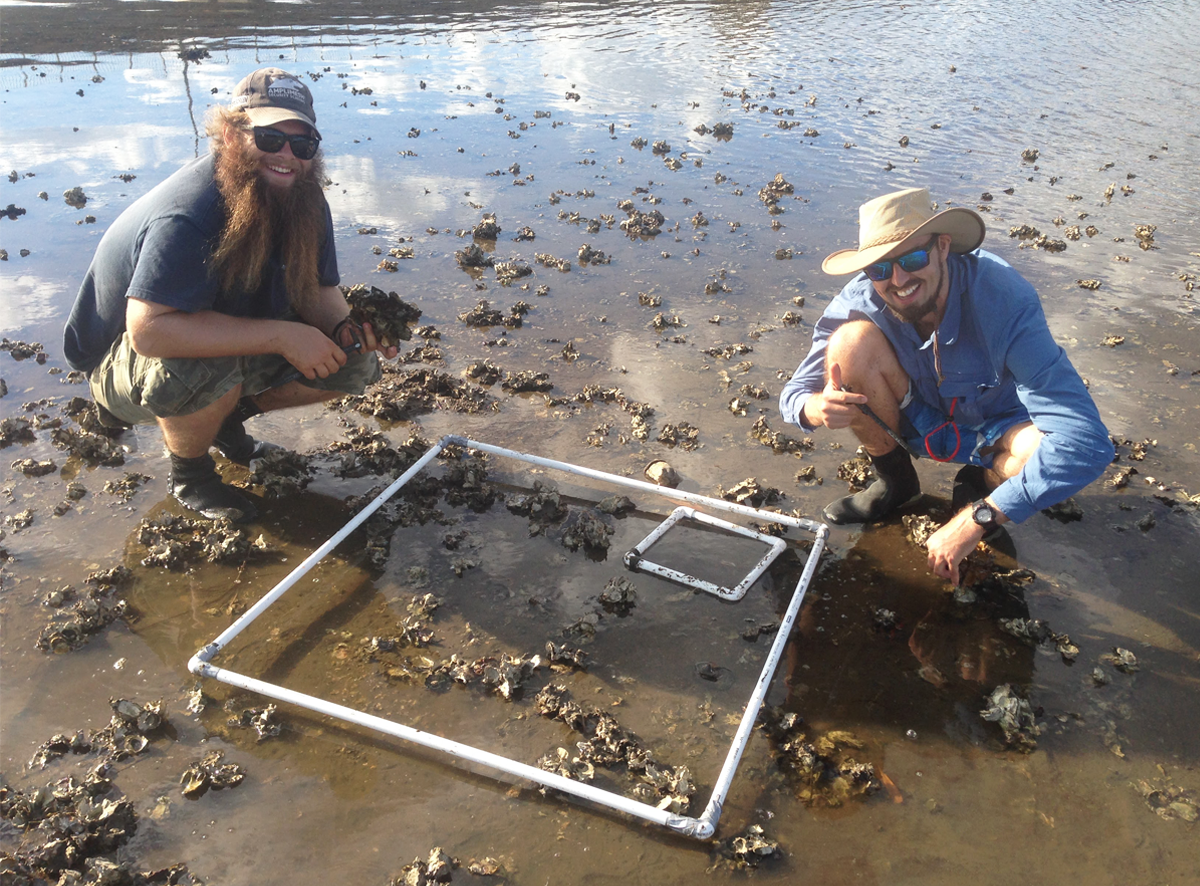July 30, 2020

While studying remnant oyster reefs at Richmond River, New South Wales, Marine Biodiversity Hub project leader Ian McLeod of James Cook University and his team observed many Hercules club mud whelks (Pyrazus ebeninus) with oysters growing on their shells.
Hercules whelks are common large marine snails on Australia’s eastern coast. They grow to 100 mm in length and feed on detritus and algae that grow on mud. True to their name, they are foundational heroes of the oyster reef, yet with their strength comes the ultimate sacrifice.
‘Some whelks carried up to four large oysters on their shell, and as the oysters grew larger, the whelks slowed and sank lower into the mud,’ Dr McLeod says. ‘We presumed this would eventually lead to the death of the whelk and the formation of a new oyster clump.’

Dr McLeod and his colleagues were intrigued by the phenomenon because oyster larvae only settle on hard substrates. ‘The oyster shells then provide a settlement surface for reefs to grow on, with the oysters themselves providing chemical and sound cues that facilitate larval settlement,’ he says. ‘Such reefs often form on intertidal sand and mud banks, however. How can this be possible in the absence of hard surfaces?’
Solving such ecological puzzles is difficult because so few oyster reefs remain to study. Globally, oyster reefs have declined by 85% through destructive overfishing, coastal development, pollution, introduced competitors, predators and diseases. Hub research has shown that more than 90% have been lost in Australia. Active restoration is increasingly popular, including in Australia, but not always successful. Knowledge about how reefs naturally form and function is vital to improve success.
The team turned to the literature for clues, discovering historical newspaper accounts. One from 1891 noted: “bank oysters may attach to rocks, dead shell known as cultch or as more frequently, attach to the shell of the Hercules whelk, [...] and are ferried to various areas of the feeding grounds, until the whelk is overwhelmed and dies from the burden”. In addition, an archaeological investigation into 1000-year-old Aboriginal middens in south-eastern Queensland found that seven percent of oyster valves probably had been hauled about by Hercules.
‘We suspect that Hercules whelks play a unique facilitative role for oysters as ecosystem engineers in sediment-dominated estuarine environments through epibiosis,’ Dr McLeod says. ‘Epibiosis is a relationship between two organisms, of which one lives on the other, but is not parasitic. In the absence of hard surfaces on mud banks, epibiosis provides the only way for oysters to expand into these habitats.
‘Subsequent generations of oyster larvae can then settle on oyster shells creating a self-sustaining ecosystem, no longer reliant on whelks as substrate. The Hercules–oyster relationship is significant because it appears to be facultative for an entire ecosystem and not just individuals.’
Epibiosis as a driver of ecosystem change is likely to be under-recognized in the marine environment. There are thousands of examples of marine epibiosis that range from barnacles growing on whales and microcolonisers such as bacteria and algal spores. Gruesome examples include invasive Pacific oysters in the Dutch Wadden Sea, which have overgrown and replaced native blue mussel (Mytilis edulis) beds by settling on their shells. Pacific oysters also grow on the shells of the gastropod Littorina littorea (Periwinkles), reducing their ability to move and reproduce.

While the interaction between Hercules whelks and oysters is a similar process to these examples, the Hercules whelks and oysters are both native species in Australia. Therefore this is likely to be a natural process. This knowledge is important to restoring Australia’s oyster reefs which are often replaced by ‘bare’ soft sediments.
This study shows the importance of understanding ecological processes including epibiosis, particularly in the context of the growing field of restoration. It also emphasises the importance of going beyond the contemporary scientific literature in a rapidly changing world to include historical context from scientific naturalists for baselines and understanding natural ecosystem function.
This research is reported in the journal Ecology.
- Log in to post comments
